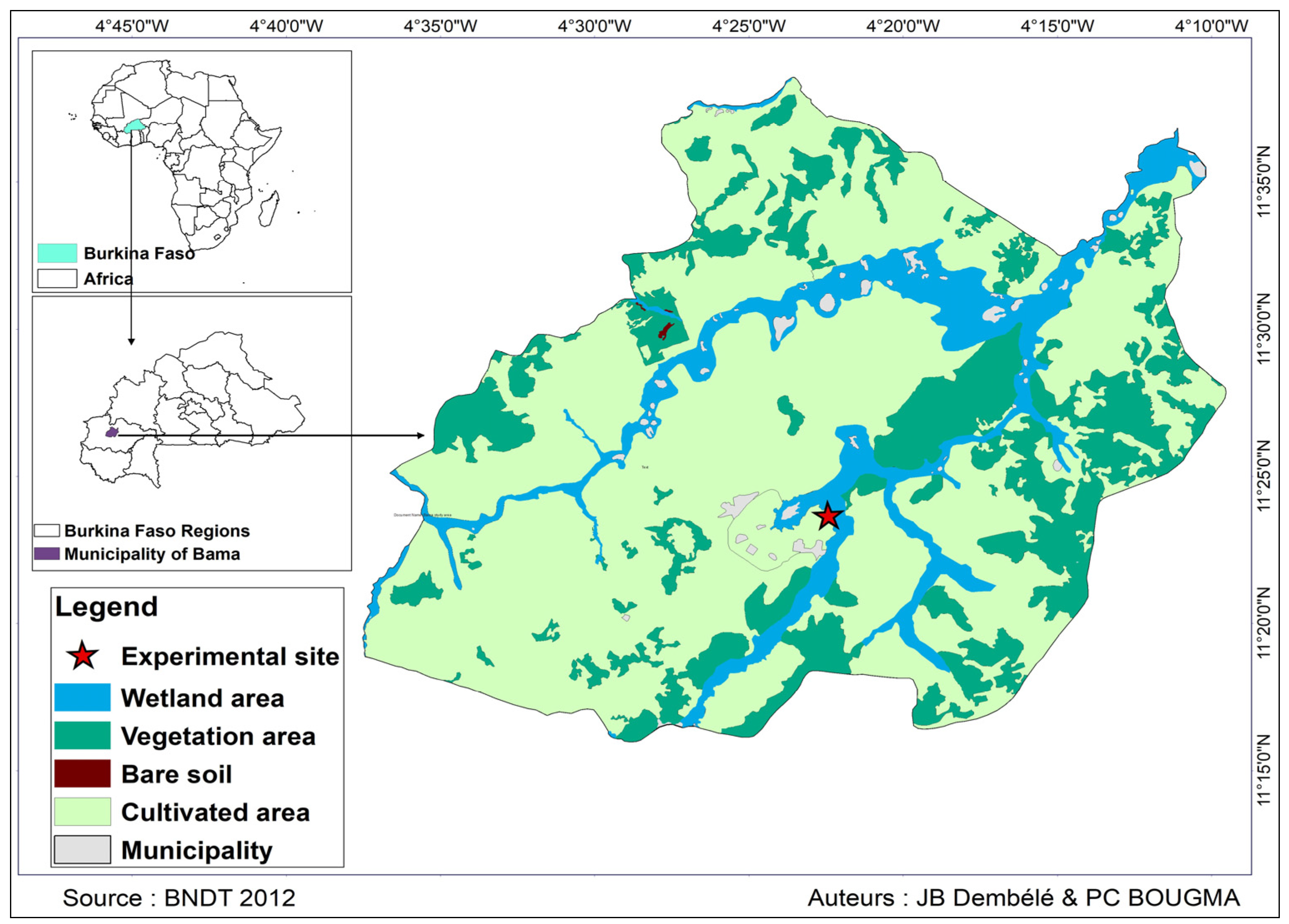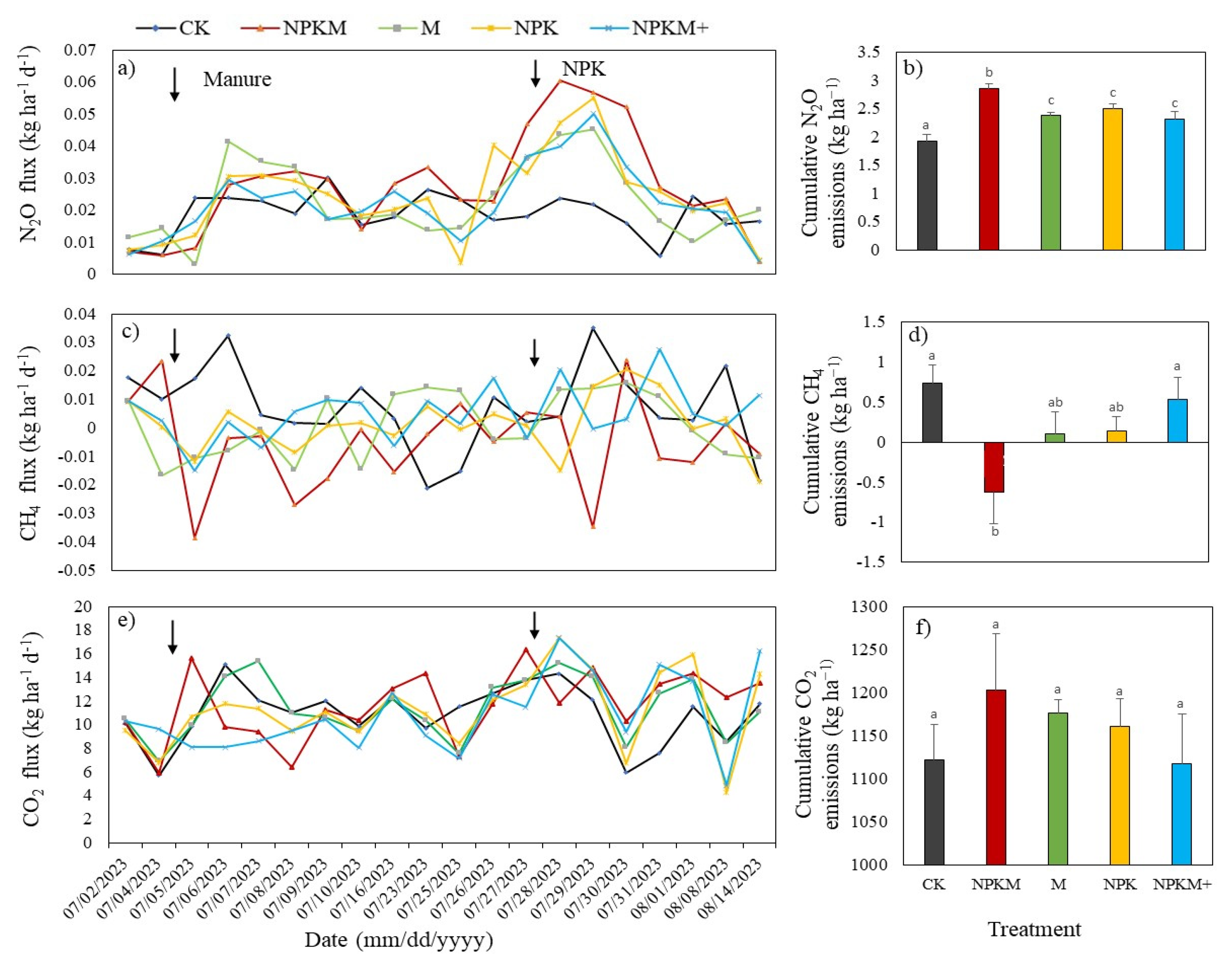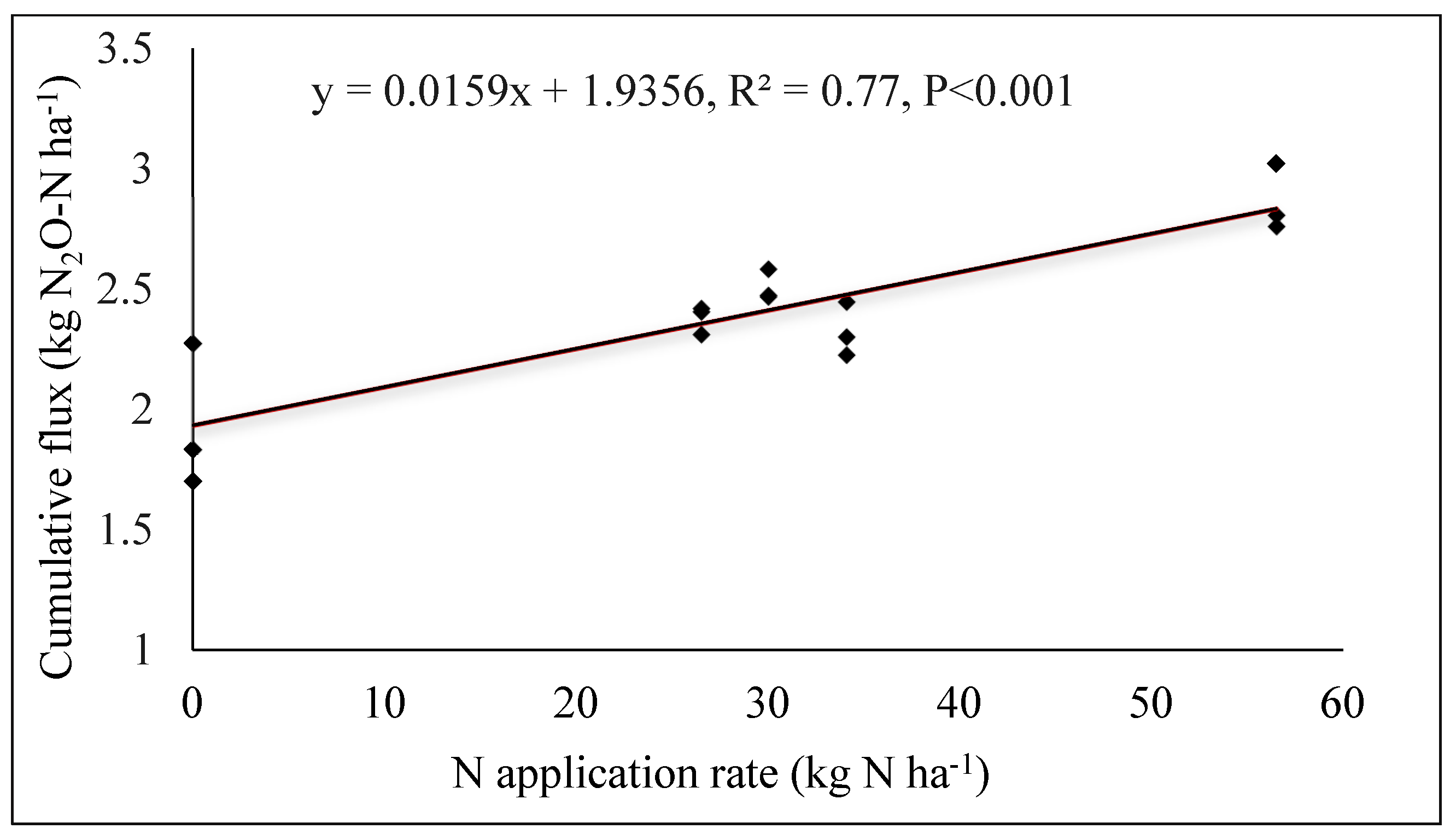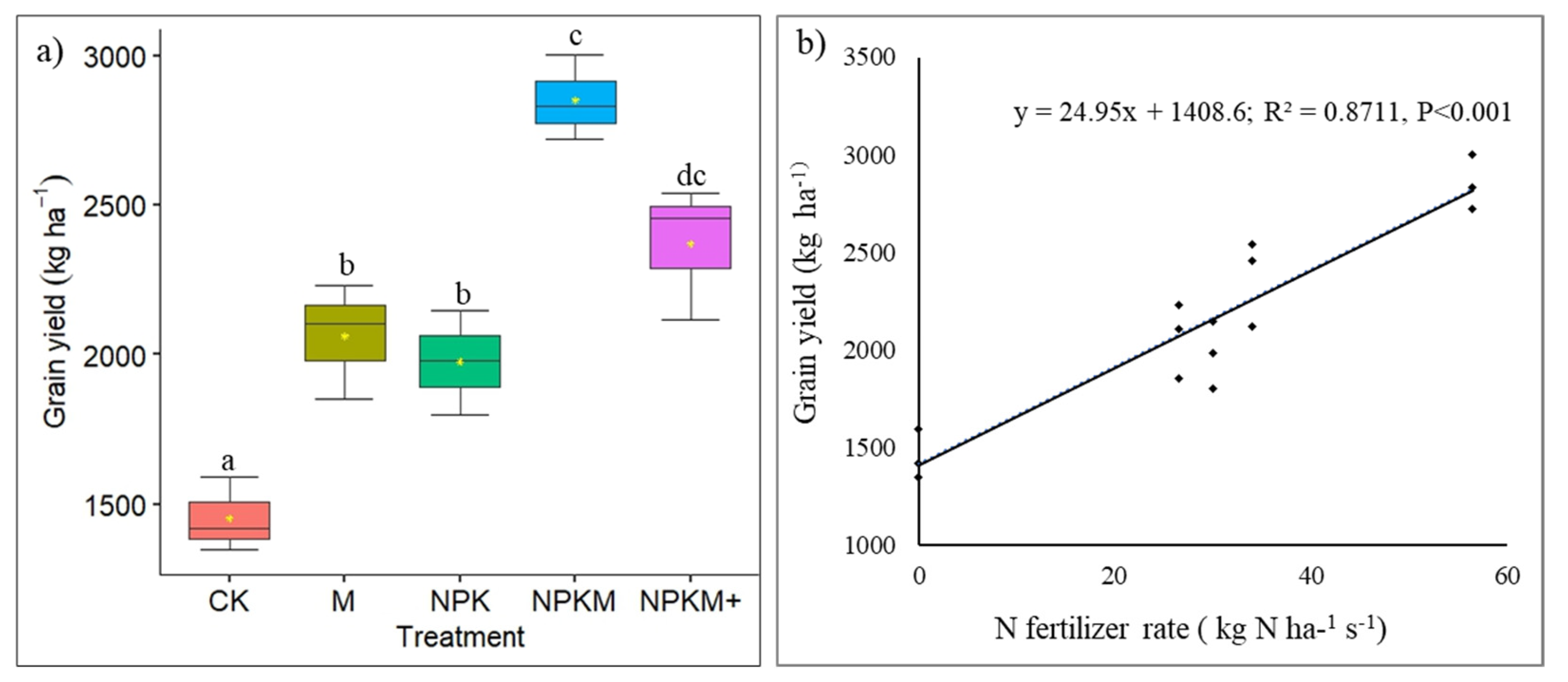Greenhouse Gas Emissions from Fertilization Practices in Maize Cropping in Sub-Saharan Africa: Toward Climate-Smart Agriculture
Abstract
1. Introduction
2. Materials and Methods
2.1. Study Area
2.2. Experimental Design and Crop Management
2.3. Gas Sampling and Measurements
2.4. Auxiliary Measurements
2.5. Estimation of Grain Yields
2.6. Soil Sampling and Analysis
2.7. Data Calculation
2.7.1. Cumulative CO2, CH4, and N2O Emissions
2.7.2. Grain Yield Calculation
2.7.3. Global Warming Potential (GWP) and Greenhouse Gas Intensity (GHGI)
2.7.4. Calculation of Yield-Scaled N2O Emissions
2.7.5. Nitrous Oxide Emissions Factors Calculation
2.8. Statistical Tests
3. Results
3.1. Environmental Variables
3.2. Dynamics of N2O, CH4, and CO2 Fluxes
3.2.1. Daily Dynamics
3.2.2. Cumulative Emissions of N2O, CH4 and CO2
3.3. N2O Emission Factor, Yield-Scaled N2O Emission, Global Warming Potential, and GHG Intensity
3.4. Relationship Between N Rate and N2O Emissions During Maize Growth Season
3.5. Effect of Fertilizer Application on Maize Grain
4. Discussion
4.1. Effect of Fertilizer Treatment on N2O Emissions
4.2. Effect of Fertilizer Treatment on CH4 Emissions
4.3. Effect of Fertilizer Treatment on CO2 Emissions
4.4. Effect of Fertilizer Treatments on N2O Emission Factors
4.5. Yield-Scaled N2O Emissions, Global Warming Potential, and GHG Intensity Following Fertilization Practices
4.6. Effect of Maize Grain Yield to Nitrogen Fertilizers
5. Conclusions
Supplementary Materials
Author Contributions
Funding
Data Availability Statement
Acknowledgments
Conflicts of Interest
References
- IPCC. Climate Change 2022: Mitigation of Climate Change; Contribution of Working Group 656 III to the Sixth Assessment Report of the Intergovernmental Panel on Climate Change, 657 Chapter 11; Climate Change; IPCC: Geneva, Switzerland, 2022. [Google Scholar]
- Ge, X.; Xie, D.; Mulder, J.; Duan, L. Reevaluating the Drivers of Fertilizer-Induced N2O Emission: Insights from Interpretable Machine Learning. Environ. Sci. Technol. 2024, 58, 15672–15680. [Google Scholar] [CrossRef] [PubMed]
- Guo, C.; Liu, X.; He, X. A Global Meta-Analysis of Crop Yield and Agricultural Greenhouse Gas Emissions under Nitrogen Fertilizer Application. Sci. Total Environ. 2022, 831, 154982. [Google Scholar] [CrossRef] [PubMed]
- Yao, Z.; Guo, H.; Wang, Y.; Zhan, Y.; Zhang, T.; Wang, R.; Zheng, X.; Butterbach-Bahl, K. A Global Meta-Analysis of Yield-Scaled N2O Emissions and Its Mitigation Efforts for Maize, Wheat, and Rice. Glob. Chang. Biol. 2024, 30, e17177. [Google Scholar] [CrossRef] [PubMed]
- Liang, L.L.; Grantz, D.A.; Jenerette, G.D. Multivariate Regulation of Soil CO2 and N2O Pulse Emissions from Agricultural Soils. Glob. Chang. Biol. 2016, 22, 1286–1298. [Google Scholar] [CrossRef]
- Pelster, D.; Rufino, M.; Rosenstock, T.; Mango, J.; Saiz, G.; Diaz-Pines, E.; Baldi, G.; Butterbach-Bahl, K. Smallholder Farms in Eastern African Tropical Highlands Have Low Soil Greenhouse Gas Fluxes. Biogeosciences 2017, 14, 187–202. [Google Scholar] [CrossRef]
- Shakoor, A.; Shahzad, S.M.; Chatterjee, N.; Arif, M.S.; Farooq, T.H.; Altaf, M.M.; Tufail, M.A.; Dar, A.A.; Mehmood, T. Nitrous Oxide Emission from Agricultural Soils: Application of Animal Manure or Biochar? A Global Meta-Analysis. J. Environ. Manag. 2021, 285, 112170. [Google Scholar] [CrossRef]
- Cowan, N.; Levy, P.; Moring, A.; Simmons, I.; Bache, C.; Stephens, A.; Marinheiro, J.; Brichet, J.; Song, L.; Pickard, A.; et al. Nitrogen Use Efficiency and N2O and NH3 Losses Attributed to Three Fertiliser Types Applied to an Intensively Managed Silage Crop. Biogeosciences 2019, 16, 4731–4745. [Google Scholar] [CrossRef]
- Menegat, S.; Ledo, A.; Tirado, R. Greenhouse Gas Emissions from Global Production and Use of Nitrogen Synthetic Fertilisers in Agriculture. Sci. Rep. 2022, 12, 14490. [Google Scholar] [CrossRef]
- Tian, H.; Xu, R.; Canadell, J.G.; Thompson, R.L.; Winiwarter, W.; Suntharalingam, P.; Davidson, E.A.; Ciais, P.; Jackson, R.B.; Janssens-Maenhout, G.; et al. A Comprehensive Quantification of Global Nitrous Oxide Sources and Sinks. Nature 2020, 586, 248–256. [Google Scholar] [CrossRef]
- Omotoso, A.B.; Omotayo, A.O. The Interplay between Agriculture, Greenhouse Gases, and Climate Change in Sub-Saharan Africa. Reg. Environ. Chang. 2024, 24, 1. [Google Scholar] [CrossRef]
- Manka’abusi, D.; Lompo, D.J.P.; Steiner, C.; Ingold, M.; Akoto-Danso, E.K.; Werner, S.; Häring, V.; Nyarko, G.; Marschner, B.; Buerkert, A. Carbon Dioxide and Gaseous Nitrogen Emissions from Biochar-Amended Soils under Wastewater Irrigated Urban Vegetable Production of Burkina Faso and Ghana. J. Plant Nutr. Soil Sci. 2020, 183, 500–516. [Google Scholar] [CrossRef]
- Tongwane, M.I.; Moeletsi, M.E. A Review of Greenhouse Gas Emissions from the Agriculture Sector in Africa. Agric. Syst. 2018, 166, 124–134. [Google Scholar] [CrossRef]
- Xia, F.; Mei, K.; Xu, Y.; Zhang, C.; Dahlgren, R.A.; Zhang, M. Response of N2O Emission to Manure Application in Field Trials of Agricultural Soils across the Globe. Sci. Total Environ. 2020, 733, 139390. [Google Scholar] [CrossRef] [PubMed]
- Wang, X.; Bai, J.; Xie, T.; Wang, W.; Zhang, G.; Yin, S.; Wang, D. Effects of Biological Nitrification Inhibitors on Nitrogen Use Efficiency and Greenhouse Gas Emissions in Agricultural Soils: A Review. Ecotoxicol. Environ. Saf. 2021, 220, 112338. [Google Scholar] [CrossRef]
- IPCC. Chapter 11: N2O Emissions from Managed Soils, and CO2 Emissions from Lime and Urea Application; IPCC: Geneva, Switzerland, 2019. [Google Scholar]
- Umemiya, C.; White, M.K. National GHG Inventory Capacity in Developing Countries–a Global Assessment of Progress. Clim. Policy 2024, 24, 164–176. [Google Scholar] [CrossRef]
- Cui, X.; Zhou, F.; Ciais, P.; Davidson, E.A.; Tubiello, F.N.; Niu, X.; Ju, X.; Canadell, J.G.; Bouwman, A.F.; Jackson, R.B.; et al. Global Mapping of Crop-Specific Emission Factors Highlights Hotspots of Nitrous Oxide Mitigation. Nat. Food 2021, 2, 886–893. [Google Scholar] [CrossRef]
- Githongo, M.W.; Musafiri, C.M.; Macharia, J.M.; Kiboi, M.N.; Fliessbach, A.; Muriuki, A.; Ngetich, F.K. Greenhouse Gas Fluxes from Selected Soil Fertility Management Practices in Humic Nitisols of Upper Eastern Kenya. Sustainability 2022, 14, 1938. [Google Scholar] [CrossRef]
- Zheng, J.; Qu, Y.; Kilasara, M.M.; Mmari, W.N.; Funakawa, S. Soil-Atmosphere Exchange of Nitrous Oxide in Two Tanzanian Croplands: Effects of Nitrogen and Stover Management. Agric. For. Meteorol. 2019, 275, 24–36. [Google Scholar] [CrossRef]
- Yang, X.; Li, S.; Du, T.; Kang, S.; Siddique, K.H.M.; Butterbach-Bahl, K. Greenhouse Gas Emissions and Crop-Specific Emission Factors of Eight Upland Crops Based on a Six-Year Field Experiment in the North China Plain. Sustain. Prod. Consum. 2024, 50, 416–430. [Google Scholar] [CrossRef]
- Leitner, S.; Pelster, D.E.; Werner, C.; Merbold, L.; Baggs, E.M.; Mapanda, F.; Butterbach-Bahl, K. Closing Maize Yield Gaps in Sub-Saharan Africa Will Boost Soil N2O Emissions. Curr. Opin. Environ. Sustain. 2020, 47, 95–105. [Google Scholar] [CrossRef]
- Musafiri, C.M.; Macharia, J.M.; Kiboi, M.N.; Ng’etich, O.K.; Shisanya, C.A.; Okeyo, J.M.; Mugendi, D.N.; Okwuosa, E.A.; Ngetich, F.K. Soil Greenhouse Gas Fluxes from Maize Cropping System under Different Soil Fertility Management Technologies in Kenya. Agric. Ecosyst. Environ. 2020, 301, 107064. [Google Scholar] [CrossRef]
- Macharia, J.M.; Pelster, D.E.; Ngetich, F.K.; Shisanya, C.A.; Mucheru-Muna, M.; Mugendi, D.N. Soil Greenhouse Gas Fluxes From Maize Production Under Different Soil Fertility Management Practices in East Africa. J. Geophys. Res. Biogeosci. 2020, 125, e06977. [Google Scholar] [CrossRef]
- Raji, G.S.; Dörsch, P. Effect of Legume Intercropping on N2O Emissions and CH4 Uptake during Maize Production in the Great Rift Valley, Ethiopia. Biogeosciences 2020, 17, 345–359. [Google Scholar] [CrossRef]
- Bougma, P.t.C.; Bondé, L.; Yaro, V.S.O.; Gebremichael, A.W.; Ouédraogo, O. Assessing Carbon Emissions from Biomass Burning in Croplands in Burkina Faso, West Africa. Fire 2023, 6, 402. [Google Scholar] [CrossRef]
- Yaro, V.S.O.; Bondé, L.; Bougma, P.T.C.; Sedgo, I.; Guuroh, R.T.; Gebremichael, A.W.; Neya, T.; Linstädter, A.; Ouédraogo, O. Greenhouse Gas Emission from Prescribed Fires Is Influenced by Vegetation Types in West African Savannas. Sci. Rep. 2024, 14, 23754. [Google Scholar] [CrossRef]
- Atakora, W.K.; Kwakye, P.K.; Weymann, D.; Brüggemann, N. Stimulus of Nitrogen Fertilizers and Soil Characteristics on Maize Yield and Nitrous Oxide Emission from Ferric Luvisol in the Guinea Savanna Agro-Ecological Zone of Ghana. Sci. Afr. 2019, 6, e00141. [Google Scholar] [CrossRef]
- Alasinrin, S.Y.; Salako, F.K.; Busari, M.A.; Sainju, U.M.; Badmus, B.S.; Isimikalu, T.O. Greenhouse Gas Emissions in Response to Tillage, Nitrogen Fertilization, and Manure Application in the Tropics. Soil. Tillage Res. 2024, 245, 106296. [Google Scholar] [CrossRef]
- Ntinyari, W.; Gweyi-Onyango, J.P. Greenhouse Gases Emissions in Agricultural Systems and Climate Change Effects in Sub- Saharan Africa. In African Handbook of Climate Change Adaptation; Springer International Publishing: Berlin/Heidelberg, Germany, 2021; pp. 1081–1105. ISBN 9783030451066. [Google Scholar]
- Liu, P.; Lin, Y.; Liu, X.; Deng, M.; Zhang, P.; Ren, X.; Chen, X. Manure Substitution with Appropriate N Rate Enhanced the Soil Quality, Crop Productivity and Net Ecosystem Economic Benefit: A Sustainable Rainfed Wheat Practice. Field Crops Res. 2023, 304, 109164. [Google Scholar] [CrossRef]
- Wang, Y.; Li, Q.; Li, C. Organic Fertilizer Has a Greater Effect on Soil Microbial Community Structure and Carbon and Nitrogen Mineralization than Planting Pattern in Rainfed Farmland of the Loess Plateau. Front. Environ. Sci. 2023, 11, 1232527. [Google Scholar] [CrossRef]
- Wang, J.; Hussain, S.; Sun, X.; Chen, X.; Ma, Z.; Zhang, Q.; Yu, X.; Zhang, P.; Ren, X.; Saqib, M.; et al. Nitrogen Application at a Lower Rate Reduce Net Field Global Warming Potential and Greenhouse Gas Intensity in Winter Wheat Grown in Semi-Arid Region of the Loess Plateau. Field Crops Res. 2022, 280, 108475. [Google Scholar] [CrossRef]
- Yona, L.; Cashore, B.; Jackson, R.B.; Ometto, J.; Bradford, M.A. Refining National Greenhouse Gas Inventories. Ambio 2020, 49, 1581–1586. [Google Scholar] [CrossRef] [PubMed]
- Akiyama, H.; Sano, T.; Nishina, K.; Sudo, S.; Oura, N.; Fujimori, M.; Uezono, I.; Yano, S.; Ohkoshi, S.; Fujita, Y.; et al. N2O Emission Factors for Organic Amendments in Japan from Measurement Campaign and Systematic Review. Sci. Total Environ. 2023, 864, 161088. [Google Scholar] [CrossRef] [PubMed]
- He, Z.; Xia, Z.; Zhang, Y.; Liu, X.; Oenema, O.; Ros, G.H.; de Vries, W.; Xu, W.; Hou, Y.; Wang, H.; et al. Ammonia Mitigation Measures Reduce Greenhouse Gas Emissions from an Integrated Manure-Cropland System. J. Clean. Prod. 2023, 422, 138561. [Google Scholar] [CrossRef]
- Sriphirom, P.; Chidthaisong, A.; Yagi, K.; Nobuntou, W.; Luanmanee, S.; Boonapatcharoen, N.; Suksong, W. Direct Nitrous Oxide Emissions from a Crop Rotation of Maize and Mung Bean after Different Long-Term Fertilizer Applications in Thailand. Field Crops Res. 2024, 312, 109382. [Google Scholar] [CrossRef]
- Lompo, D.J.P.; Sangaré, S.A.K.; Compaoré, E.; Papoada Sedogo, M.; Predotova, M.; Schlecht, E.; Buerkert, A. Gaseous Emissions of Nitrogen and Carbon from Urban Vegetable Gardens in Bobo-Dioulasso, Burkina Faso. J. Plant Nutr. Soil. Sci. 2012, 175, 846–853. [Google Scholar] [CrossRef]
- FAO. International Institute for Applied Systems Analysis (IIASA); FAO: Rome, Italy, 2023. [Google Scholar]
- Oertel, C.; Matschullat, J.; Zurba, K.; Zimmermann, F.; Erasmi, S. Greenhouse Gas Emissions from Soils—A Review. Chem. Der Erde 2016, 76, 327–352. [Google Scholar] [CrossRef]
- Charteris, A.F.; Chadwick, D.R.; Thorman, R.E.; Vallejo, A.; de Klein, C.A.M.; Rochette, P.; Cárdenas, L.M. Global Research Alliance N2O Chamber Methodology Guidelines: Recommendations for Deployment and Accounting for Sources of Variability. J. Environ. Qual. 2020, 49, 1092–1109. [Google Scholar] [CrossRef]
- de Klein, C.A.M.; Alfaro, M.A.; Giltrap, D.; Topp, C.F.E.; Simon, P.L.; Noble, A.D.L.; van der Weerden, T.J. Global Research Alliance N2O Chamber Methodology Guidelines: Statistical Considerations, Emission Factor Calculation, and Data Reporting. J. Environ. Qual. 2020, 49, 1156–1167. [Google Scholar] [CrossRef]
- Brümmer, C.; Brüggemann, N.; Butterbach-Bahl, K.; Falk, U.; Szarzynski, J.; Vielhauer, K.; Wassmann, R.; Papen, H. Soil-Atmosphere Exchange of N2O and NO in near-Natural Savanna and Agricultural Land in Burkina Faso (W. Africa). Ecosystems 2008, 11, 582–600. [Google Scholar] [CrossRef]
- Kum, C.T.; Ngwabie, N.M.; Tening, A.S.; Tsamo, C. Soil Greenhouse Gas Fluxes and Net Global Warming Potential from Two Maize Farming Practices in the Bamenda Highlands, Cameroon. Heliyon 2024, 10, e34855. [Google Scholar] [CrossRef]
- Niu, Y.; Luo, J.; Liu, D.; Müller, C.; Zaman, M.; Lindsey, S.; Ding, W. Effect of Biochar and Nitrapyrin on Nitrous Oxide and Nitric Oxide Emissions from a Sandy Loam Soil Cropped to Maize. Biol. Fertil. Soils 2018, 54, 645–658. [Google Scholar] [CrossRef]
- Bandyopadhyay, K.; Aggarwal, P.; Chakraborty, D.; Profile, S.; Pradhan, S. Practical Manual on Measurement of Soil Physical Properties Practical; Notion Press: Chennai, India, 2012; ISBN 9788188708796. [Google Scholar]
- Kim, G.W.; Gutierrez-Suson, J.; Kim, P.J. Optimum N Rate for Grain Yield Coincides with Minimum Greenhouse Gas Intensity in Flooded Rice Fields. Field Crops Res. 2019, 237, 23–31. [Google Scholar] [CrossRef]
- Zhang, S.; Xue, L.; Liu, J.; Jia, P.; Feng, Y.; Xu, Y.; Li, Z.; Zhao, X. One–Third Substitution of Nitrogen with Cow Manure or Biochar Greatly Reduced N2O Emission and Carbon Footprint in Saline–Alkali Soils. Field Crops Res. 2024, 316, 109517. [Google Scholar] [CrossRef]
- Tandzi, L.N.; Mutengwa, C.S. Estimation of Maize (Zea mays L.) Yield Per Harvest Area: Appropriate Methods. Agronomy 2020, 10, 29. [Google Scholar] [CrossRef]
- Lightfoot, H.D.; Ratzer, G. Reliable Physics Demand Revision of the IPCC Global Warming Potentials. J. Basic. Appl. Sci. 2024, 20, 54–58. [Google Scholar] [CrossRef]
- Liang, Z.; Jin, X.; Zhai, P.; Zhao, Y.; Cai, J.; Li, S.; Yang, S.; Li, C.; Li, C. Combination of Organic Fertilizer and Slow-Release Fertilizer Increases Pineapple Yields, Agronomic Efficiency and Reduces Greenhouse Gas Emissions under Reduced Fertilization Conditions in Tropical Areas. J. Clean. Prod. 2022, 343, 131054. [Google Scholar] [CrossRef]
- R Core Team. A Language and Environment for Statistical Computing. R Foundation for Statistical Computing; R Core Team: Vienna, Austria, 2023. [Google Scholar]
- Liu, B.; Frostegård, Å.; Bakken, L.R. Impaired Reduction of N2O to N2 in Acid Soils Is Due to a Posttranscriptional Interference with the Expression of NosZ. mBio 2014, 5, e01383-14. [Google Scholar] [CrossRef]
- Gao, Z.; Wang, C.; Zhao, J.; Wang, K.; Shang, M.; Qin, Y.; Bo, X.; Chen, F.; Chu, Q. Adopting Different Irrigation and Nitrogen Management Based on Precipitation Year Types Balances Winter Wheat Yields and Greenhouse Gas Emissions. Field Crops Res. 2022, 280, 108484. [Google Scholar] [CrossRef]
- Pei, Y.; Chen, X.; Niu, Z.; Su, X.; Wang, Y.; Wang, X. Effects of Nitrogen Fertilizer Substitution by Cow Manure on Yield, Net GHG Emissions, Carbon and Nitrogen Footprints in Sweet Maize Farmland in the Pearl River Delta in China. J. Clean. Prod. 2023, 399, 136676. [Google Scholar] [CrossRef]
- Zhang, Y.; Guo, G.; Wu, H.; Mu, Y.; Liu, P.; Liu, J.; Zhang, C. The Coupling Interaction of NO2− with NH4+ or NO3− as an Important Source of N2O Emission from Agricultural Soil in the North China Plain. Sci. Total Environ. 2019, 692, 82–88. [Google Scholar] [CrossRef]
- Huang, R.; Wang, Y.; Liu, J.; Gao, J.; Zhang, Y.; Ni, J.; Xie, D.; Wang, Z.; Gao, M. Partial Substitution of Chemical Fertilizer by Organic Materials Changed the Abundance, Diversity, and Activity of NirS-Type Denitrifying Bacterial Communities in a Vegetable Soil. Appl. Soil. Ecol. 2020, 152, 103589. [Google Scholar] [CrossRef]
- Nyamadzawo, G.; Shi, Y.; Chirinda, N.; Olesen, J.E.; Mapanda, F.; Wuta, M.; Wu, W.; Meng, F.; Oelofse, M.; de Neergaard, A.; et al. Combining Organic and Inorganic Nitrogen Fertilisation Reduces N2O Emissions from Cereal Crops: A Comparative Analysis of China and Zimbabwe. Mitig. Adapt. Strateg. Glob. Chang. 2017, 22, 233–245. [Google Scholar] [CrossRef]
- Xu, Y.; Luo, B.; Jia, R.; Xiao, J.; Wang, X.; Yang, Y.; Xue, S.; Zeng, Z.; Brown, R.W.; Zang, H. Quantifying Synergies and Trade-Offs in the Food-Energy-Soil-Environment Nexus under Organic Fertilization. J. Environ. Manag. 2024, 349, 119526. [Google Scholar] [CrossRef] [PubMed]
- Zhang, T.; Liu, H.; Luo, J.; Wang, H.; Zhai, L.; Geng, Y.; Zhang, Y.; Li, J.; Lei, Q.; Bashir, M.A.; et al. Long-Term Manure Application Increased Greenhouse Gas Emissions but Had No Effect on Ammonia Volatilization in a Northern China Upland Field. Sci. Total Environ. 2018, 633, 230–239. [Google Scholar] [CrossRef]
- Hickman, J.E.; Tully, K.L.; Groffman, P.M.; Diru, W.; Palm, C.A. A Potential Tipping Point in Tropical Agriculture: Avoiding Rapid Increases in Nitrous Oxide Fluxes from Agricultural Intensification in Kenya. J. Geophys. Res. Biogeosci. 2015, 120, 938–951. [Google Scholar] [CrossRef]
- Pareja-Sánchez, E.; Cantero-Martínez, C.; Álvaro-Fuentes, J.; Plaza-Bonilla, D. Tillage and Nitrogen Fertilization in Irrigated Maize: Key Practices to Reduce Soil CO2 and CH4 Emissions. Soil. Tillage Res. 2019, 191, 29–36. [Google Scholar] [CrossRef]
- Fernández-Ortega, J.; Álvaro-Fuentes, J.; Cantero-Martínez, C. Double-Cropping, Tillage and Nitrogen Fertilization Effects on Soil CO2 and CH4 Emissions. Agric. Ecosyst. Environ. 2024, 359, 108758. [Google Scholar] [CrossRef]
- Ren, F.; Zhang, X.; Liu, J.; Sun, N.; Wu, L.; Li, Z.; Xu, M. A Synthetic Analysis of Greenhouse Gas Emissions from Manure Amended Agricultural Soils in China. Sci. Rep. 2017, 7, 8123. [Google Scholar] [CrossRef]
- Knief, C. Diversity of Methane-Cycling Microorganisms in Soils and Their Relation to Oxygen. Curr. Issues Mol. Biol. 2019, 33, 23–56. [Google Scholar] [CrossRef]
- Zhang, S.; Zamanian, K.; Raza, S.; Raheb, A.; Feng, Y.; Zhao, X. A Balance among Irrigation and Fertilization Regimes to Reduce Greenhouse Gases Emissions from Saline and Alkaline Soils. Land Degrad. Dev. 2024, 35, 168–182. [Google Scholar] [CrossRef]
- Grace, P.; De Rosa, D.; Shcherbak, I.; Strazzabosco, A.; Rowlings, D.; Scheer, C.; Barton, L.; Wang, W.; Schwenke, G.; Armstrong, R.; et al. Revised Emission Factors for Estimating Direct Nitrous Oxide Emissions from Nitrogen Inputs in Australia’s Agricultural Production Systems: A Meta-Analysis. Soil. Res. 2023, 62, SR23070. [Google Scholar] [CrossRef]
- Thorman, R.E.; Nicholson, F.A.; Topp, C.F.E.; Bell, M.J.; Cardenas, L.M.; Chadwick, D.R.; Cloy, J.M.; Misselbrook, T.H.; Rees, R.M.; Watson, C.J.; et al. Towards Country-Specific Nitrous Oxide Emission Factors for Manures Applied to Arable and Grassland Soils in the UK. Front. Sustain. Food Syst. 2020, 4, 62. [Google Scholar] [CrossRef]
- Zhang, X.; Fang, Q.; Zhang, T.; Ma, W.; Velthof, G.L.; Hou, Y.; Oenema, O.; Zhang, F. Benefits and Trade-Offs of Replacing Synthetic Fertilizers by Animal Manures in Crop Production in China: A Meta-Analysis. Glob. Chang. Biol. 2020, 26, 888–900. [Google Scholar] [CrossRef]
- Yue, Q.; Wu, H.; Sun, J.; Cheng, K.; Smith, P.; Hillier, J.; Xu, X.; Pan, G. Deriving Emission Factors and Estimating Direct Nitrous Oxide Emissions for Crop Cultivation in China. Environ. Sci. Technol. 2019, 53, 10246–10257. [Google Scholar] [CrossRef]
- Rahman, M.S.; Ferdous, J.; Mumu, N.J.; Kamruzzaman, M.; Eckhardt, C.; Zaman, M.; Müller, C.; Jahangir, M.M.R. Crop Residues Integration with Nitrogen Rates Reduces Yield-Scaled Nitrous Oxide Emissions and Improves Maize Yield and Soil Quality. J. Integr. Environ. Sci. 2024, 21, 2310856. [Google Scholar] [CrossRef]
- Hu, Y.; Li, D.; Wu, Y.; Liu, S.; Li, L.; Chen, W.; Wu, S.; Meng, Q.; Feng, H.; Siddique, K.H.M. Mitigating Greenhouse Gas Emissions by Replacing Inorganic Fertilizer with Organic Fertilizer in Wheat–Maize Rotation Systems in China. J. Environ. Manag. 2023, 344, 118494. [Google Scholar] [CrossRef]
- Wang, Y.; Liu, X.; Yan, Q.; Hu, Y. Impacts of Slash Burning on Soil Carbon Pools Vary with Slope Position in a Pine Plantation in Subtropical China. Catena 2019, 183, 104212. [Google Scholar] [CrossRef]
- Menšík, L.; Hlisnikovský, L.; Pospíšilová, L.; Kunzová, E. The Effect of Application of Organic Manures and Mineral Fertilizers on the State of Soil Organic Matter and Nutrients in the Long-Term Field Experiment. J. Soils Sediments 2018, 18, 2813–2822. [Google Scholar] [CrossRef]
- Wang, H.; Xu, J.; Liu, X.; Zhang, D.; Li, L.; Li, W.; Sheng, L. Effects of Long-Term Application of Organic Fertilizer on Improving Organic Matter Content and Retarding Acidity in Red Soil from China. Soil Tillage Res. 2019, 195, 104382. [Google Scholar] [CrossRef]
- Aluoch, S.O.; Li, Z.; Li, X.; Hu, C.; Mburu, D.M.; Yang, J.; Xu, Q.; Yang, Y.; Su, H. Effect of Mineral N Fertilizer and Organic Input on Maize Yield and Soil Water Content for Assessing Optimal N and Irrigation Rates in Central Kenya. Field Crops Res. 2022, 277, 108420. [Google Scholar] [CrossRef]






| Treatment | CK | NPKM | M | NPK | NPKM+ |
|---|---|---|---|---|---|
| Characteristic | Control (no fertilizer) | Conventional mixture fertilization (manure + chemical fertilizers) | Manure fertilization | Chemical fertilization (NPK) | Local mixture fertilization (informal combination) |
| Fertlizers rate | 0 | 5 t ha−1 M + 200 kg ha−1 NPK | 5 t ha−1 M | 200 kg ha−1 NPK | 3.6 t ha−1 M + 100 kg ha−1 NPK |
| Nitrogen rate (kg N ha−1) | 0 | 26.5 | 30 | 34.08 | 56.5 |
| Treatment | Emission Factors (%) | Total GWP (kg CO2 eq. ha−1) | GHGI (kg CO2 eq. kg−1 Grain Yield) | YSNE (g N2O-N kg−1 Grain) | Gas Contribution in GWP (%) | ||
|---|---|---|---|---|---|---|---|
| N2O | CH4 | CO2 | |||||
| CK | - | 1670.93 ± 136.18 a | 1.15 ± 0.16 a | 1.34 ± 0.17 a | 31.54 ± 1.23 a | 1.20 ± 0.13 a | 67.26 ± 1.25 a |
| NPKM | 0.31 ± 0.05 a | 1968.32 ± 114.82 b | 0.69 ± 0.006 b | 1.01 ± 0.04 a | 39.85 ± 1.88 b | −0.89 ± 0.74 b | 61.04 ± 1.15 b |
| M | 0.32 ± 0.08 a | 1829.65 ± 51.12 ab | 0.89 ± 0.10 ab | 1.16 ± 0.07 a | 35.53 ± 0.27 ab | 0.14 ± 0.32 ab | 64.33 ± 0.43 ab |
| NPK | 0.37 ± 0.05 a | 1850.21 ± 71.93 ab | 0.94 ± 0.10 ab | 1.27 ± 0.06 a | 37.07 ± 0.61 b | 0.20 ± 0.19 ab | 62.73 ± 0.55 b |
| NPKM+ | 0.22 ± 0.10 a | 1767.74 ± 107.47 ab | 0.74 ± 0.03 b | 0.98 ± 0.03 a | 35.95 ± 0.29 ab | 0.85 ± 0.49 ab | 63.20 ± 0.74 ab |
| p-Value | 0.580 | 0.0545 | 0.0025 | 0.074 | 0.003 | 0.052 | 0.006 |
Disclaimer/Publisher’s Note: The statements, opinions and data contained in all publications are solely those of the individual author(s) and contributor(s) and not of MDPI and/or the editor(s). MDPI and/or the editor(s) disclaim responsibility for any injury to people or property resulting from any ideas, methods, instructions or products referred to in the content. |
© 2025 by the authors. Licensee MDPI, Basel, Switzerland. This article is an open access article distributed under the terms and conditions of the Creative Commons Attribution (CC BY) license (https://creativecommons.org/licenses/by/4.0/).
Share and Cite
Bougma, P.-t.C.; Bondé, L.; Yaro, V.S.O.; Dicko, I.; Zongo, A.F.R.; Gebremichael, A.W.; Mohamed, M.; Malz, C.; Matschullat, J.; Linstädter, A.; et al. Greenhouse Gas Emissions from Fertilization Practices in Maize Cropping in Sub-Saharan Africa: Toward Climate-Smart Agriculture. Environments 2025, 12, 211. https://doi.org/10.3390/environments12070211
Bougma P-tC, Bondé L, Yaro VSO, Dicko I, Zongo AFR, Gebremichael AW, Mohamed M, Malz C, Matschullat J, Linstädter A, et al. Greenhouse Gas Emissions from Fertilization Practices in Maize Cropping in Sub-Saharan Africa: Toward Climate-Smart Agriculture. Environments. 2025; 12(7):211. https://doi.org/10.3390/environments12070211
Chicago/Turabian StyleBougma, Pawend-taoré Christian, Loyapin Bondé, Valaire Séraphin Ouehoudja Yaro, Idrissa Dicko, Aurelie Flavy Rufine Zongo, Amanuel Woldeselassie Gebremichael, Mounkaila Mohamed, Claudia Malz, Jörg Matschullat, Anja Linstädter, and et al. 2025. "Greenhouse Gas Emissions from Fertilization Practices in Maize Cropping in Sub-Saharan Africa: Toward Climate-Smart Agriculture" Environments 12, no. 7: 211. https://doi.org/10.3390/environments12070211
APA StyleBougma, P.-t. C., Bondé, L., Yaro, V. S. O., Dicko, I., Zongo, A. F. R., Gebremichael, A. W., Mohamed, M., Malz, C., Matschullat, J., Linstädter, A., & Ouédraogo, O. (2025). Greenhouse Gas Emissions from Fertilization Practices in Maize Cropping in Sub-Saharan Africa: Toward Climate-Smart Agriculture. Environments, 12(7), 211. https://doi.org/10.3390/environments12070211







